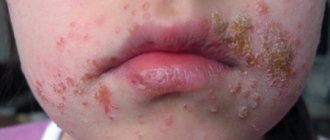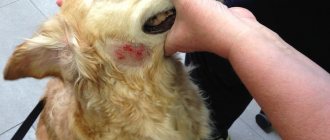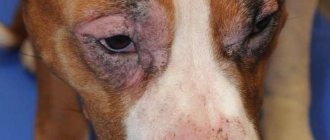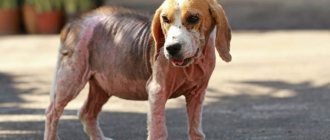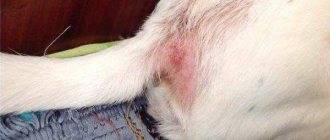All types of pyoderma in dogs are characterized by purulent inflammations provoked by the penetration of pyogenic cocci under the skin. Most often, signs of disease appear in places with sparse hair growth - in the mucocutaneous areas and folds of the lips. This disease is mainly diagnosed in bulldogs, boxers, Pekingese and spaniels. In some cases, therapy is carried out through surgical excision of the affected skin folds.
Causes of pyoderma in dogs
Pyoderma refers to a group of skin diseases accompanied by purulent inflammation. The disease develops under the influence of factors leading to maceration of the skin - increased humidity, folds, temperature, decreased immune defense. As a result, the normal flora is replaced by pathogenic flora and purulent inflammation develops. Predisposing factors for pyoderma include:
- inflammatory processes in the skin, subcutaneous tissue;
- flea dermatitis;
- scabies, itching;
- poor care;
- disruption of the formation of the stratum corneum of the epidermis;
- metabolic disease;
- suppression of resistance;
- use of glucocorticoids and other drugs.
Dogs with short hair and folds in the skin are predisposed to pyoderma. The most pathological course is observed in German shepherds, in which the disease often cannot be treated and constant relapses occur. The genetic mechanism of inheritance of this predisposition has not been studied.
Pustular inflammation of the skin occurs against the background of allergic reactions, dermatitis, parasitic diseases, and fungal infections. In the summer, there is an increase in the number of cases of pyoderma. This is due to increased humidity and ambient temperature. Frequent injuries from thorny plant seeds are also observed when walking dogs.
In case of skin diaper rash, microbes do not affect living tissues, but penetrate into the surface layer of the epidermis - horny scales. If the infection is localized below the stratum corneum, then the hair follicles and glands are involved in the pathological process. Deeper infection leads to the formation of boils. This form usually develops against the background of primary pathology.
A major role in the pathogenesis belongs to severe itching, which causes injury to the skin. Self-injury in dogs is associated with attempts to relieve itching and pain, but scratching the skin with claws leads to the development of a purulent infection. The itching is caused by allergies, scabies mites, and fleas. The disease affects all dogs, but is most common in the following breeds:
- Golden retriever;
- Labrador;
- collie;
- German Shepherd.
During diagnosis, various microorganisms are detected, the most common of which are Staphylococcus aureus, Proteus and Pasteurella. But their role in pathogenesis has not been studied. This microflora is normal for most animals and does not cause a pathological condition. It is believed that a predisposing factor (allergies, parasites, injuries) lead to the creation of optimal conditions for the development of microbes.
Obese dogs and older animals are prone to skin fold pyoderma. A breed predisposition is noted in Shar-Peis, spaniels, and French bulldogs. All these breeds are characterized by highly folded skin.
Interdigital pyoderma is observed in hunting breeds of dogs. Its development is promoted by excessive licking of paws. Boxers experience this type of pyoderma due to hypersensitivity. Often during diagnosis, yeast fungi and demodicosis are detected.
Why is this pathology becoming more and more common?
Recently, this disease has become very common.
This happens because dog owners give their pets freeze-dried food, rarely walk them (especially for city animals), and engage in breeding without knowing all the intricacies of this matter. As a result, individuals appear with poor body condition. Therefore, it is not surprising that pyoderma in dogs is not a rare phenomenon.
We should also not forget that the environment is getting worse, and this can also be considered one of the factors provoking the disease we are considering.
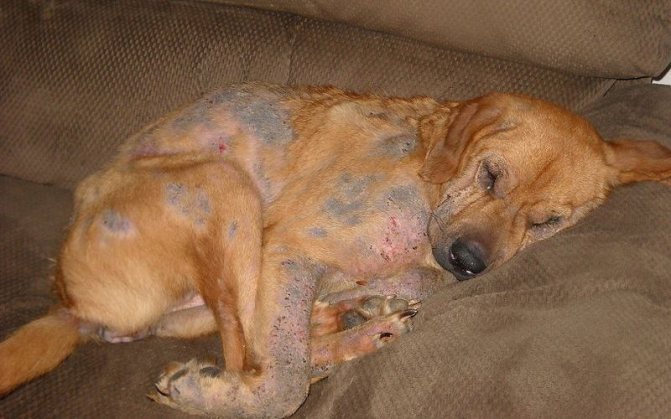
Symptoms and diagnosis
The disease develops rapidly - owners report that the signs appeared recently. This is due to the fact that due to severe itching, the dog itself injures the skin by scratching it with its paw claws. Scratching is not a primary change, the type of which depends on the form of skin lesion.
There are three clinical groups of pyoderma in dogs:
- diaper rash of the folds of the lips, vulva, tail, manifested by hot, weeping spots;
- superficial rash and follicle damage;
- deep pyoderma, accompanied by acne, damage to the interdigital gap.
Diaper rash in dogs appears in the area of skin folds - on the sacrum, around the anus, on the muzzle, and on the ears. Such spots have a regular defined shape with erythematous or ulcerative inflammation. The affected area is hairless and covered with exudate or crusts.
Superficial pyoderma can develop throughout the body. Signs of deep purulent skin lesions are found on the back of the nose, chin, and paws. The disease, caused by itching or staphylococcal skin infection, often occurs in an acute form. If the pathology is caused by allergies, then as the itching decreases, dogs remain with a pronounced rash on the skin.
Pyoderma, which is a sign of endocrine pathology, is accompanied by increased thirst, increased urination, general lethargy, and exhaustion. After eliminating the damage to the metabolic organs, the itching goes away along with the pustules. Itching and other signs of skin damage can indicate a variety of diseases, so it is important to conduct additional research:
- skin scraping is done to exclude scabies mites, demodicosis, microsporia;
- if these tests are unsuccessful, a bacterial culture is done to determine the bacterial infection and its sensitivity to antibiotics;
- allergic diagnostics are carried out - sensitivity is identified, various types of food are gradually excluded;
- laboratory diagnosis of immune and metabolic problems.
Superficial purulent dermatitis in dogs is not accompanied by pronounced changes in laboratory tests of blood and plasma. Shifts in the leukogram and biochemistry are detected due to primary factors (metabolic disorders, systemic pathology) or concomitant diseases . An increase in the number of leukocytes and increased activity of alkaline phosphatase indicates damage to the adrenal system. Eosinophilia accompanies various parasitic diseases.
A smear from the affected area followed by bacteriology reveals staphylococci, less often other microorganisms. The most accurate results are obtained by culture of the contents of intact pustules. A biopsy is also done for deep skin lesions, exudate and crusts are collected.
Pathological material is selected by biopsy or impression smears are made, which are stained according to Romanovsky. Microscopy reveals coccal forms located inside or outside the cell. Rods may also be detected, in most cases indicating a secondary infection. For deep infections, culture and antibiotic sensitivity testing are indicated.
Features of treatment
Therapy begins with hair removal. The hair is shaved over the entire affected area, capturing healthy tissue. Then the affected area is washed with chlorhexidine solution.
For treatment, local and systemic drugs are used. Ointments, creams and sealed dressings (plasters) should be avoided, as they will prevent the drainage of exudate and may cause deeper forms of pyoderma. Treatment of superficial spots is carried out using lotions and sprays that have an antipruritic, cooling effect. The active ingredients in such preparations are:
- menthol;
- camphor;
- thymol.
The use of alcohol preparations should be careful. On the one hand, these products have an astringent and bactericidal effect, but they can also irritate the skin, intensifying the local reaction. For treatment, an alcohol tincture of iodine, povidone-iodine, is used.
The best results are obtained by a combination of antibacterial drugs and glucocorticoids. To treat pyoderma in dogs, products containing neomycin and prednisolone are used.
Local treatment allows you to remove crusts, improve blood supply to the skin in the affected area, reduce itching, and speed up healing. Bathing dogs with special shampoos (containing chlorhexidine, ethyl acetate) is carried out 1-2 times a week. Treatments with sprays and other drugs are carried out daily for pyoderma of the folds and acne.
Courses of antibiotics are used as systemic therapy:
- cephalexin;
- ormetroprim and sulfadimethoxine;
- lincomycin;
- amoxicillin;
- enrofloxacin.
Treatment with systemic antibiotics is carried out in long courses of 2-3 weeks. It is also recommended not to stop giving antibiotics for another 7 days from the moment the symptoms disappear. While taking antibiotics, repeat examinations are carried out every week; if there is no improvement, then it is better to change the drug.
For pyoderma of skin folds, surgical intervention is often prescribed. Conservative treatment in such cases is often ineffective - high humidity constantly remains in the folds, which promotes maceration of the skin and the growth of microorganisms. Therefore, excision of folds and plastic surgery of the skin is indicated.
List of drugs against the disease
The list of drugs used in the treatment of dermatitis is extensive and depends on the specific diagnosis of the dog. Most often used:
| Drug name | Price | Mode of application |
| Prednisolone 5 mg, 100 tablets. |
69 rub.
Anti-inflammatory, antiallergic agent.
46 rub.
The dosage is prescribed individually.
1200-4000 rub.
The active ingredient cyclosporine is the main medicine for Ecoral and Sandimmune.
A powerful immunosuppressant.
700 rub.
Antibiotic in powder form for solution preparation (intramuscular).
The dosage is prescribed individually.
Folk remedies to help
As first aid for a pet suffering from dermatitis, you can use folk remedies:
- Vegetables. The main assistant is potatoes, from which you can make compresses on painful places. Used in grated form with a gauze bandage.
- Fruits. Lotions made from a decoction of leaves are considered a good remedy. 200 gr. finely chopped leaves must be boiled for 5 minutes in 500 ml. water. Leave for 12 hours.
- Decoctions. Chamomile has an anti-inflammatory, soothing effect. Calendula has bactericidal properties and is used to disinfect wounds; in the form of an ointment, it is effective for cuts and erosions. Witch hazel reduces pain, relieves inflammation and swelling, and has antibacterial characteristics.
Dermatitis is a serious condition that can be caused by numerous factors. Self-diagnosis is difficult, and immediate contact with a specialist is necessary. The veterinarian will be able to determine the nature of the disease, prescribe appropriate treatment and help the pet.
| Dexamethasone 5ml, drops |
| Cyclosporine, 50 mg |
| Ceftriaxone 1 g, 50 bottle. |
Preventive actions
Pyoderma in dogs is a factor disease. Streptococci, staphylococci and other microorganisms are normal skin flora and exhibit pathogenic qualities only in the presence of primary pathologies. Therefore, it is important to protect the animal from other diseases:
- Regularly treat your pet for parasites;
- do cleaning and disinfection;
- carry out vaccinations annually;
- carry out a clinical examination and, if necessary, conduct laboratory and instrumental studies.
A big role is played by the dog's nutrition. Obesity is a very important factor that reduces immunity. In addition, pyoderma often develops in the fatty folds of the skin. Feeding should vary depending on the loads received during work (for service dogs) and training, age, weight, and physical condition.
Prevention
- Trim long hair regularly and carefully inspect the animal's skin.
- Pay special attention to the folds of the skin, as these are where a large number of microorganisms most often accumulate. In hot weather, sweat can accumulate in the folds and, as a result, eczema develops.
- Your pet should always have a complete, balanced diet, vitamins and microelements. Consult your veterinarian about the advisability of purchasing special vitamin complexes for your dog.
- If possible, it is necessary to eliminate all factors that can provoke an infectious process in the pet’s body.
- On the streets, do not allow your dog to come into contact with suspicious animals.
- If your pet is susceptible to allergic reactions, regularly carry out allergy prevention - select appropriate hair care products with your veterinarian, eliminate food allergens and the dog’s contact with household chemicals.
Any disease is much easier to prevent, so take care of your pet’s health every day, do not ignore the symptoms, even if they seem insignificant to you. Treatment of pyoderma requires long-term use of antibiotics, which are dangerous due to a wide range of side effects. Prevent your four-legged friend from getting sick, thereby making life easier for your pet and yourself.
